
AURACAST™ BROADCAST AUDIO RETROFIT SOLUTIONS AND OPPORTUNITIES
1
www.abiresearch.com
CONTENTS
Introduction .................................... 1
Growing Momentum for LE Audio
and Auracast™ Broadcast Audio ......... 2
The Opportunity for Retrofit
Auracast™ Broadcast Audio
in Public Venues ............................... 4
Retrofit Opportunity
by Market Segments ......................... 7
Education ....................................................8
Public Assembly Social and Meeting Venues ....9
Public Assembly Entertainment
and Cultural Venues ....................................9
Public Assembly Transportation Hubs .........9
Religious Worship ..................................... 10
Food Service .............................................10
Healthcare ................................................10
Lodging .....................................................11
Offices .......................................................11
Public Order and Safety ............................11
Auracast™ Broadcast Audio
Transmitter Retrofit Device
Configurations ............................... 12
Simple Auracast™ Broadcast
Audio Retrofit Transmitters ........................ 13
Conclusion and Strategic
Recommendations .......................... 15
AURACAST
™
BROADCAST
AUDIO RETROFIT SOLUTIONS
AND OPPORTUNITIES
INTRODUCTION
Bluetooth
®
LE Audio (LE Audio) is set to transform the way people experience
audio in public spaces, changing the consumer audio and assistive
listening landscape. In addition to enabling signicant reductions in power
consumption, lower latency, and higher audio quality, LE Audio will also lead
to greater standardization of audio capabilities, enabling market categories
such as true-wireless headsets and hearing aids to further ourish, while
enabling new Bluetooth
®
chipset vendors to take advantage of these growing
audio market segments. Meanwhile, the broadcast capabilities of LE Audio
technology, known as Auracast™ broadcast audio, will help enable innovative
audio usage scenarios and new product categories. This will include personal
audio sharing, the ability for a source device such as a laptop, tablet, or
television (TV) to broadcast to an unlimited number of headsets or other
receivers, and use cases within public venues, driving new ways of interacting
with audio within a wide range of establishments. In the longer term, this
will lead to millions of public venues supporting Auracast™ broadcast audio
technology across both augmented listening and assistive listening use cases,
enabling scenarios such as cinema goers to be able to listen to a movie,
travelers to better hear public announcements, gym and sports bar visitors to
unmute silent TVs, or museum goers to receive guided tours using their own
listening devices. This will enable a whole new wave of opportunities for LE
Audio within public spaces and create new and innovative consumer audio and
assistive listening applications within a wide range of device types.
Andrew Zignani,
Senior Research Director

AURACAST™ BROADCAST AUDIO RETROFIT SOLUTIONS AND OPPORTUNITIES
2
www.abiresearch.com
Opportunities for Auracast™ broadcast audio are enormous, with the technology
envisioned to be leveraged within several use cases across a wide number of public
venues. This could include audio systems within conference and lecture halls, theaters
and cinemas, and places of worship, Public Address (PA) and alert systems in airports
and transportation hubs, and eventually, one-to-one countertop deployments within
retail and other service environments.
Thanks to the numerous benets of Auracast™ broadcast audio transmitter solutions,
including simple deployment, the ability to provide consistent, high-quality, direct-to-ear
stereo audio to compatible audio devices, low infrastructure costs, interoperability, and
strong backing from the consumer audio and assistive hearing ecosystem, Auracast™
broadcast audio has the potential to signicantly build upon and complement existing
assistive listening solutions, expanding access to new venues and regions that currently
have limited or no assistive listening infrastructure. At the same time, it will enable new
audio experiences for users with or without hearing loss, further compounding the
benets of Auracast™ broadcast audio deployments and providing additional incentive
for the accelerated rollout in many venues.
GROWING MOMENTUM FOR LE AUDIO
AND AURACAST™ BROADCAST AUDIO
Since the complete suite of LE Audio specications was made available in July 2022,
momentum for LE Audio and Auracast™ broadcast audio solutions has continued to
grow. According to the bluetooth.com website, numerous products have undergone
or are in the process of undergoing Bluetooth SIG qualication that support LE Audio,
including chipsets, modules, smartphones, Personal Computers (PCs), tablets, headsets
and earbuds, TVs, speakers, hearing aids, and transmitter and receiver devices.
Propelling the LE Audio and Auracast™ broadcast audio ecosystem forward is a large
selection of chipsets from leading vendors such as Qualcomm, Broadcom, MediaTek,
Airoha, Nordic Semiconductor, NXP, Realtek, Telink, and Bestechnic, among others.
Meanwhile, key vendors in the hearing aid space have announced their support for
LE Audio and Auracast™ broadcast audio technology. In September 2023, GN Hearing
announced support within its ReSound Nexia™ hearing aids and its TV-Streamer+
device, while in November 2022, Cochlear Limited announced that it received U.S. Food
and Drug Administration (FDA) approval for its Cochlear™ Nucleus
®
8 Sound Processor,
the world’s rst cochlear implant sound processor ready to support for LE Audio and
Auracast™ broadcast audio. At the same time, while this report is being written, many
existing Bluetooth
®
audio devices are now receiving rmware updates to support LE
Audio and Auracast™ broadcast audio capabilities, further expanding the ecosystem,
while many others have the potential to be upgraded to support this functionality. This

AURACAST™ BROADCAST AUDIO RETROFIT SOLUTIONS AND OPPORTUNITIES
3
www.abiresearch.com
includes headsets and true-wireless earbuds such as the Samsung Galaxy Buds2 Pro.
Others have planned product introductions that will be announced after the publication
of this document.
There are also a growing number of source devices such as smartphones, tablets, PCs,
notebooks, and TVs that support LE Audio and Auracast™ broadcast audio technology.
While it will take some time for the entire market to transition to supporting Auracast™
broadcast audio, both from a hardware and a software perspective, encouraging signs
for adoption include LE Audio support in Android 13, support within Samsung’s Galaxy
S23 and Fold series via its One UI 6 (and higher) update, and recent announcements
that Windows 11 will add support for LE Audio and Auracast™ broadcast audio. This
will enable direct connectivity with hearing aids and other LE Audio receiver devices.
Smart TVs, including the 2023 Samsung Neo QLED 8K and MICRO LED series have
received software updates to support Auracast™ broadcast audio. Combined, these
developments point toward an accelerating ecosystem of LE Audio and Auracast™
broadcast audio-capable solutions that can support the technology at launch or
retroactively via software updates.
As Chart 1 demonstrates, ABI Research forecasts that by 2028, annual shipments
of LE Audio-enabled devices are expected to reach approximately 3 billion, growing
from 391 million in 2023. The vast majority of these will come from source devices
such as smartphones, PCs, tablets, TVs, and smartwatches, and receiver devices
such as headsets, true-wireless earbuds, hearing aids and Over-the-Counter (OTC)
hearing aids, and speakers. Please visit bluetooth.com for the latest introductions and
announcements.
Chart 1: Annual Bluetooth
®
LE Audio-Enabled Device Shipments,
World Markets: 2023 to 2028
(Source: ABI Research)
There are also a growing number of source devices such as smartphones,
tablets, PCs, notebooks, and TVs that support LE Audio and Auracast™ broadcast
audio technology. While it will take some time for the entire market to transition
to supporting Auracast™ broadcast audio, both from a hardware and a software
perspective, encouraging signs for adoption include LE Audio support in Android
13, support within Samsung’s Galaxy S23 and Fold series via its One UI 6 (and
higher) update, and recent announcements that Windows 11 will add support
for LE Audio and Auracast™ broadcast audio. This will enable direct connectivity
with hearing aids and other LE Audio receiver devices. Smart TVs, including the
2023 Samsung Neo QLED 8K and MICRO LED series have received software
updates to support Auracast™ broadcast audio. Combined, these developments
point toward an accelerating ecosystem of LE Audio and Auracast™ broadcast
audio-capable solutions that can support the technology at launch or
retroactively via software updates. As Chart 1 demonstrates, ABI Research
forecasts that by 2028, annual shipments of LE Audio-enabled devices are
expected to reach approximately 3 billion, growing from 391 million in 2023. The
vast majority of these will come from source devices such as smartphones, PCs,
tablets, TVs, and smartwatches, and receiver devices such as headsets, true-
wireless earbuds, hearing aids and Over-the-Counter (OTC) hearing aids, and
speakers.
Chart 1: Bluetooth® LE Audio-Enabled Device Shipments, World
Markets: 2023 to 2028
(Source: ABI Research)
As Chart 2 demonstrates, this growing ecosystem will incentivize millions of
venues to deploy Auracast™ broadcast audio technology over the next few
years, with public venue adoption expected to accelerate in the second half of
0.0
0.5
1.0
1.5
2.0
2.5
3.0
3.5
2023 2024 2025 2026 2027 2028
(Billions)

AURACAST™ BROADCAST AUDIO RETROFIT SOLUTIONS AND OPPORTUNITIES
4
www.abiresearch.com
As Chart 2 demonstrates, this growing ecosystem will incentivize millions of venues
to deploy Auracast™ broadcast audio technology over the next few years, with public
venue adoption expected to accelerate in the second half of this decade due to wider
availability and awareness of Auracast™ broadcast audio solutions, alongside a critical
mass of Auracast™ broadcast audio-capable receiver devices being adopted by end
users.
Chart 2: Total Auracast™ Broadcast Audio Deployments,
World Markets: 2024 to 2030
(Source: ABI Research)
THE OPPORTUNITY FOR RETROFIT AURACAST™
BROADCAST AUDIO IN PUBLIC VENUES
Given this relatively rapid adoption of LE Audio and Auracast™ broadcast audio-capable
receiver devices, including true wireless earbuds, headsets, hearing aids, and cochlear
implants, there is a new emerging opportunity for Bluetooth
®
solution providers to
develop retrot Auracast™ broadcast audio solutions for public venues that can be
simple to install, take advantage of low-cost transmitter devices, and enable a valuable
combination of new audio experiences and improved listening for both the hearing
impaired and the wider users of Bluetooth
®
audio technology. These solutions can help
bridge the gap between this early adoption period and the time in which it will take to
develop and deploy dedicated, fully integrated Auracast™ broadcast audio equipment
such as AV systems, PA systems, and specialized assistive listening infrastructure.
These retrot solutions can enhance audio for both hearing aid users and the broader
Bluetooth
®
user base, expediting deployments across a wide range of public venues
and enabling a sizable new opportunity for Bluetooth
®
solution providers to capture
before the market transition to embedded solutions is completed. Figure 1 shows how
these dierent types of retrot Auracast™ broadcast audio hardware can help address
this multitude of applications.
this decade due to wider availability and awareness of Auracast™ broadcast
audio solutions, alongside a critical mass of Auracast™ broadcast audio-capable
receiver devices being adopted by end users.
Chart 2: Total Auracast™ Broadcast Audio Deployments, World
Markets: 2024 to 2030
(Source: ABI Research)
The Opportunity for Retrofit Auracast™ Broadcast Audio in Public
Venues
Given this relatively rapid adoption of LE Audio and Auracast™ broadcast audio-
capable receiver devices, including true wireless earbuds, headsets, hearing aids,
and cochlear implants, there is a new emerging opportunity for Bluetooth®
solution providers to develop retrofit Auracast™ broadcast audio solutions for
public venues that can be simple to install, take advantage of low-cost
transmitter devices, and enable a valuable combination of new audio
experiences and improved listening for both the hearing impaired and the wider
users of Bluetooth® audio technology. These solutions can help bridge the gap
between this early adoption period and the time in which it will take to develop
and deploy dedicated, fully integrated Auracast™ broadcast audio equipment
such as AV systems, PA systems, and specialized assistive listening
infrastructure. These retrofit solutions can enhance audio for both hearing aid
users and the broader Bluetooth® user base, expediting deployments across a
wide range of public venues and enabling a sizable new opportunity for
Bluetooth® solution providers to capture before the market transition to
embedded solutions is completed. Figure 1 shows how these different types of
0
500,000
1,000,000
1,500,000
2,000,000
2,500,000
3,000,000
2024 2025 2026 2027 2028 2029 2030
Actual Deployments
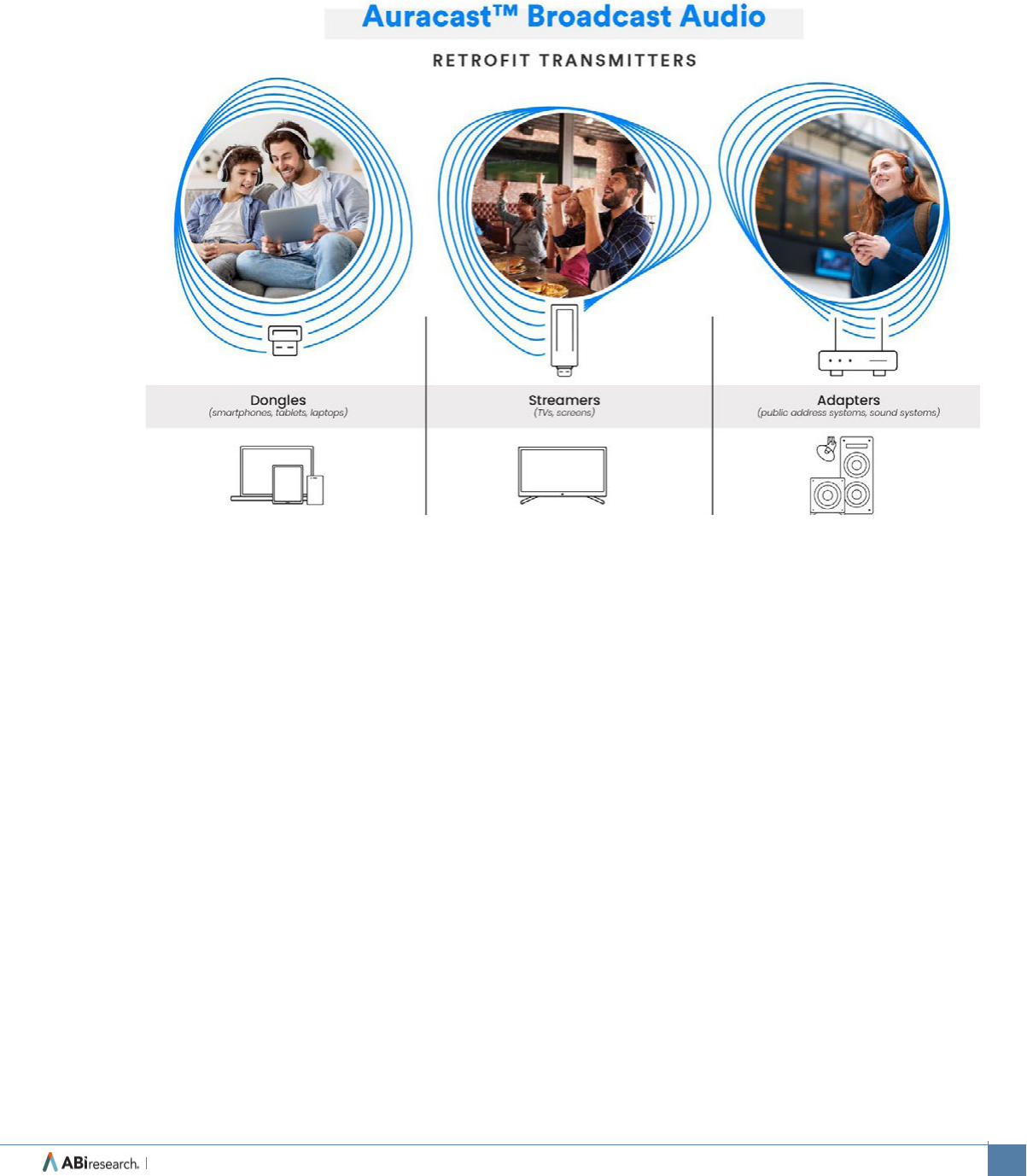
AURACAST™ BROADCAST AUDIO RETROFIT SOLUTIONS AND OPPORTUNITIES
5
www.abiresearch.com
Figure 1: Auracast™ Broadcast Audio Hardware Options for Retrofit
(Source: Bluetooth SIG)
In its most basic form, wherever there is a power source and an audio source that can
be connected, a retrot Auracast™ broadcast audio transmitter, adapter, or dongle can
be deployed to enable any one of the following Auracast™ broadcast audio use cases
identied by the Bluetooth SIG:
• Augmented Listening in Public Spaces: Venues that deploy PA systems such as
airports, cinemas, lecture halls, conference centers, places of worship, and more can
provide a better audio experience by enabling visitors to receive the PA audio directly
into their own Auracast™ broadcast audio headset or hearing device. When used
in this manner, Auracast™ broadcast audio will function as a high-quality, low-cost,
next-generation Assistive Listening System (ALS), improving the audio experience for
visitors with and without hearing loss. Retrot transmitters, adapters, and dongles
that can be tted to legacy sound systems, speakers, microphones, personal audio
devices, and other installed equipment could enable these experiences without
the need to wait for fully integrated Auracast™ broadcast audio solutions to be
developed, as well as the additional time it may take for the existing systems to be
upgraded.
• Silent TV Screens: Venues that provide silent TV screens such as airports,
gymnasiums, hotels, restaurants, and waiting rooms can oer a more satisfying
watching experience by providing access to the program’s audio for people using
their own Auracast™ broadcast audio-enabled headsets or hearing devices. Retrot
retrofit Auracast™ broadcast audio hardware can help address this multitude of
applications.
Figure 1: Auracast™ Broadcast Audio Hardware Options for
Retrofit
(Source: Bluetooth SIG)
In its most basic form, wherever there is a power source and an audio source
that can be connected, a retrofit Auracast™ broadcast audio transmitter,
adapter, or dongle can be deployed to enable one of the following Auracast™
broadcast audio use cases identified by the Bluetooth SIG:
• Augmented Listening in Public Spaces: Venues that deploy PA systems
such as airports, cinemas, lecture halls, conference centers, places of
worship, and more can provide a better audio experience by enabling
visitors to receive the PA audio directly into their own Auracast™
broadcast audio headset or hearing device. When used in this manner,
Auracast™ broadcast audio will function as a high-quality, low-cost, next-
generation Assistive Listening System (ALS), improving the audio
experience for visitors with and without hearing loss. Retrofit transmitters,
adapters, and dongles that can be fitted to legacy sound systems,
speakers, microphones, personal audio devices, and other installed
equipment could enable these experiences without the need to wait for
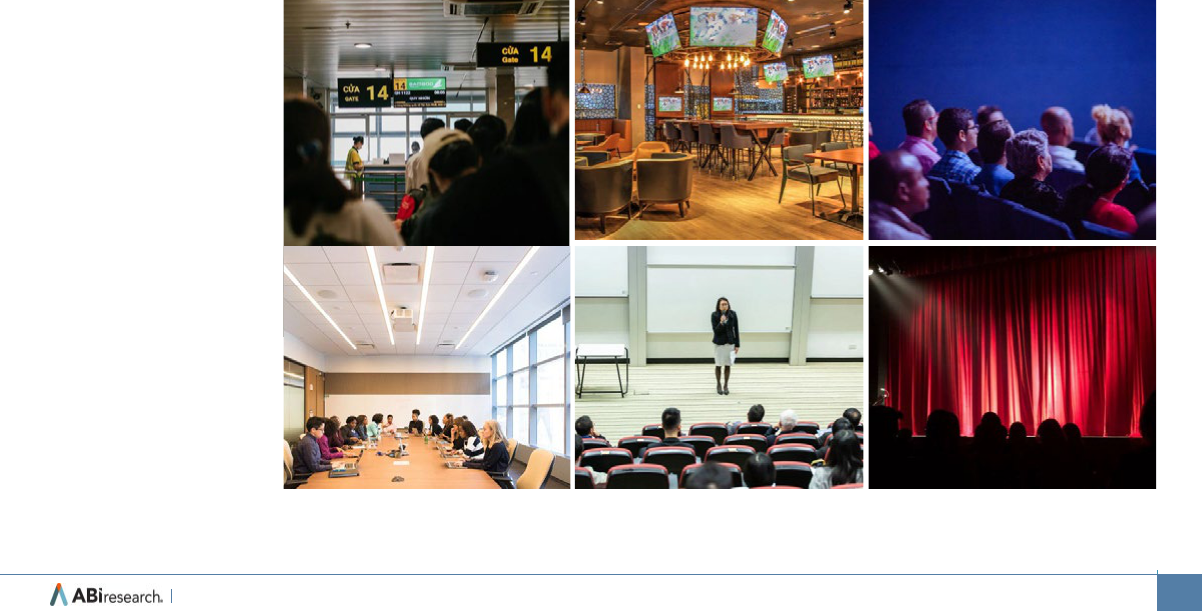
AURACAST™ BROADCAST AUDIO RETROFIT SOLUTIONS AND OPPORTUNITIES
6
www.abiresearch.com
High-Denition Multimedia Interface (HDMI), Universal Serial Bus (USB), or auxiliary
dongles that can be connected to TVs already deployed in these venues could be a
low-cost alternative to purchasing a new TV with embedded Auracast™ broadcast
audio support.
• Multi-Language Support: Venues that support simultaneous interpretation services
such as conference and meeting centers, or alternative language programming
for video programming can provide a more engaging audio experience and let
participants use their own Auracast™ broadcast audio headsets or hearing devices
to receive audio in their desired language. Retrot transmitters equipped with
existing audio systems have the ability to broadcast multiple simultaneous streams,
potentially enabling synchronized multi-language content in places like conference
venues, cinemas, airports, and railway stations.
• Tour Systems: Venues that provide guided group tours such as museums,
convention centers, and tourist attractions can create a more compelling tour
experience by enabling visitors to use their own Auracast™ broadcast audio-enabled
headsets or hearing devices when participating in the tour. Retrot solutions could
potentially be designed to integrate with already existing tour guide systems, or
enable venues to use personal audio devices such as smartphones as tour systems,
which can be easily retrotted with an Auracast™ broadcast audio dongle.
Figure 2 shows what ABI Research expects to be some of the typical deployment
scenarios for retrot Auracast™ broadcast audio solutions.
Figure 2: Potential Retrofit Auracast™ Broadcast Audio Deployment Environments
(Source: ABI Research)
Within these environments, Auracast™ broadcast audio transmitters, adapters,
and dongles can be simply connected to a wide range of existing audio sources,
including:
• TVs deployed in airports, bars, gymnasiums, hotels, and other public
venues
• PA systems across a wide range of environments, including transportation
hubs, education campuses, and healthcare facilities
• Lecture hall and classroom communication systems
• Place of worship communication systems
• Conference room speakers in offices, hotels, smart buildings, and
convention centers
• Audio mixers and racks in theaters, cinemas, and other public
entertainment venues
• Stadium audio systems
• Tour guide systems within museums, galleries, and other tourist
attractions
Auracast™ broadcast audio technology is expected to be embedded in both
public venue-deployed source devices (e.g., TVs), dedicated assistive listening
equipment, or as part of the product offering for professional Audio-Visual (AV)
solution providers over time. However, given the large number of venues and
audio sources already deployed globally, this will create a sizable potential
retrofit market opportunity for Auracast™ broadcast audio technology. These

AURACAST™ BROADCAST AUDIO RETROFIT SOLUTIONS AND OPPORTUNITIES
7
www.abiresearch.com
Within these environments, Auracast™ broadcast audio transmitters, adapters, and
dongles can be simply connected to a wide range of existing audio sources, including:
• TVs deployed in airports, bars, gymnasiums, hotels, and other public venues
• PA systems across a wide range of environments, including transportation hubs,
education campuses, and healthcare facilities
• Lecture hall and classroom communication systems
• Place of worship communication systems
• Conference room speakers in oces, hotels, smart buildings, and convention centers
• Audio mixers and racks in theaters, cinemas, and other public entertainment venues
• Stadium audio systems
• Tour guide systems within museums, galleries, and other tourist attractions
Auracast™ broadcast audio technology is expected to be embedded in both public venue-
deployed source devices (e.g. TVs), dedicated assistive listening equipment, or as part
of the product oering for professional Audio-Visual (AV) solution providers over time.
However, given the large number of venues and audio sources already deployed globally,
this will create a sizable potential retrot market opportunity for Auracast™ broadcast
audio technology. These retrot solutions will also help raise awareness of Auracast™
broadcast audio technology and enable benets for both assistive listening use cases and
wider consumer augmented listening experiences. Combined, these will help incentivize
investment in Auracast™ broadcast audio technology, educate consumers and venues
on the benets, accelerate the development of dedicated hardware solutions, and drive
further adoption in both mainstream source and receiver devices.
RETROFIT OPPORTUNITY
BY MARKET SEGMENTS
Figure 3 maps the various retrot Auracast™ broadcast audio opportunities in terms
of viability and ease of installation. Some retrot use cases will be easier to deploy
and require less complexity. One of the more obvious larger-scale and easy to deploy
Auracast™ broadcast audio deployments will be silent TV applications across a range
of venues, including bars and pubs, transportation hubs, gyms, and others. Following
closely behind this will be retrot solutions that require slightly more complexity such
as integrating into existing speaker systems, audio mixers, and PA systems. These may
require additional conguration depending on the size of the room and deployment
environment. Beyond this are larger-scale venues, including transportation hubs,
stadiums, and healthcare PA systems, which could require multiple transmitters to cover a
facility and are more dicult to physically install in the existing audio sources.
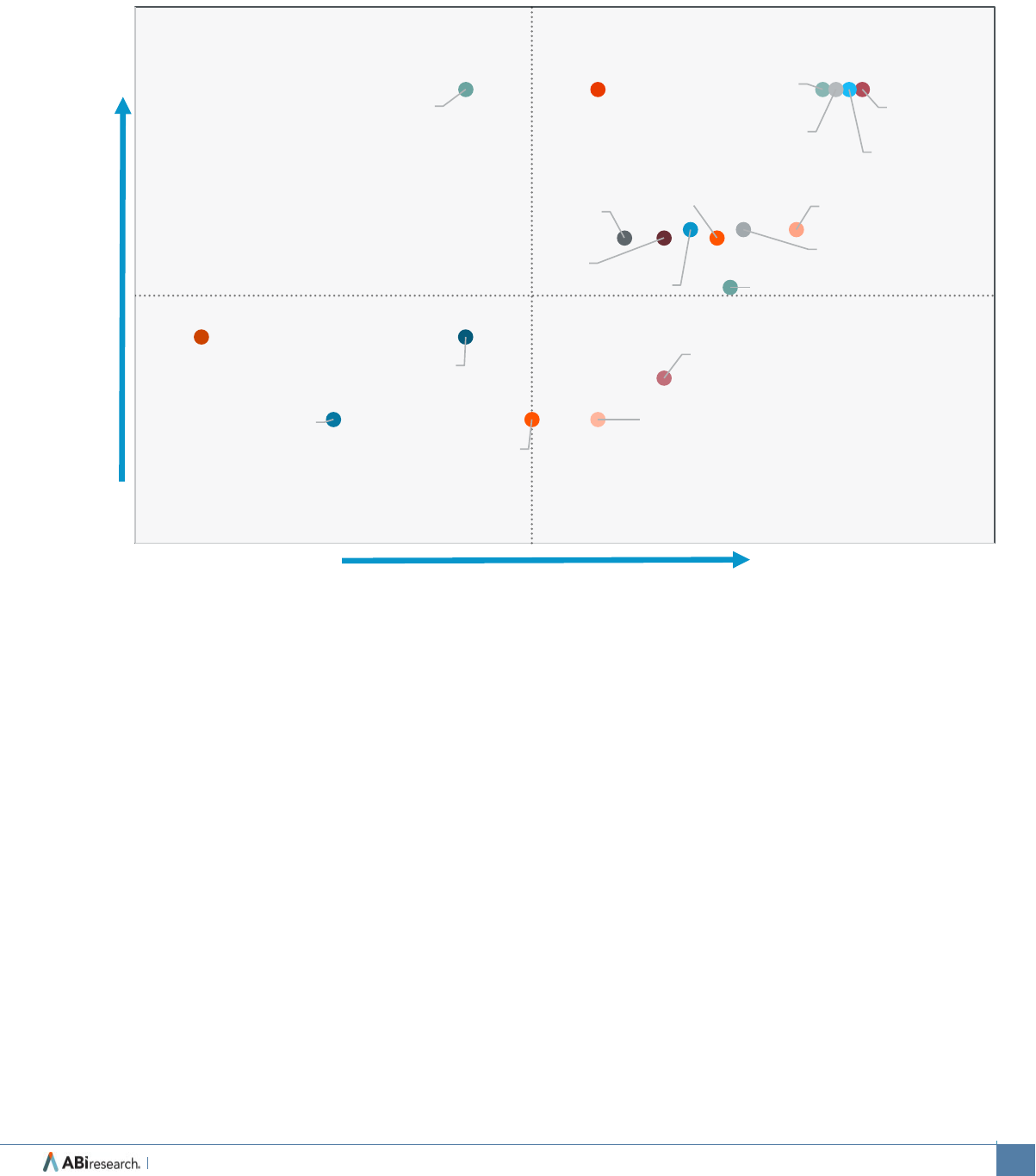
AURACAST™ BROADCAST AUDIO RETROFIT SOLUTIONS AND OPPORTUNITIES
8
www.abiresearch.com
Figure 3: Retrofit Auracast™ Broadcast Audio Opportunity by
Viability and Ease of Installation
(Source: ABI Research)
The following sections discuss the retrot opportunity for Auracast™ broadcast audio
across the key market verticals in more detail.
Education
Educational buildings refer primarily to classroom buildings within schools, colleges,
and university campuses. The primary use case for Auracast™ broadcast audio in these
environments will be augmented and assistive listening deployments, allowing users to
receive audio from teachers and lecturers using the audio systems. Here, there could
be tens of classrooms equipped with an Auracast™ broadcast audio transmitter per
building, while for some of the largest auditoriums, additional transmitters could be
leveraged to ensure all users can connect eectively. Most lecture halls today have PA
systems that could be simply retrotted with Auracast™ broadcast audio transmitters
to provide immediate benets. In addition, many classrooms have existing speaker
systems to ensure the educator’s voice can be easily understood without the need for
them to raise their voice. There could also be opportunities for in-class microphones
and transmitters for use by students.
With nearly 2 million educational establishments globally, each with multiple buildings
with multiple classrooms, lecture halls, and seminar rooms, this could equate to an
enormous opportunity for retrofit assistive listening solutions.
The following sections discuss the retrofit opportunity for Auracast™ broadcast
audio across the key market verticals in more detail.
Education
Educational buildings refer primarily to classroom buildings within schools,
colleges, and university campuses. The primary use case for Auracast™
broadcast audio in these environments will be augmented and assistive listening
deployments, allowing users to receive audio from teachers and lecturers using
the audio systems. Here, there could be tens of classrooms equipped with an
Auracast™ broadcast audio transmitter per building, while for some of the
largest auditoriums, additional transmitters could be leveraged to ensure all
users can connect effectively. Most lecture halls today have PA systems that
could be simply retrofitted with Auracast™ broadcast audio transmitters to
provide immediate benefits. In addition, many classrooms have existing speaker
systems to ensure the educator’s voice can be easily understood without the
need for them to raise their voice. There could also be opportunities for in-class
microphones and transmitters for use by students.
With nearly 2 million educational establishments globally, each with
multiple buildings with multiple classrooms, lecture halls, and seminar
Education PA Systems
Education Classroom
Speaker Systems
Public Assembly PA Systems
Public Assembly Meeting
Room Speaker Systems
Religious Worship
Speaker Systems
Bar and Pub
Silent TVs
Healthcare PA Systems
Healthcare Silent TVs
Hospitality
Silent TVs
Hospitality Meeting Room
Speaker Systems
Office Meeting Room Speaker Systems
Gym and Health
Club Silent TVs
Entertainment and
Cultural Venue PA
Systems
Entertainment and
Cultural Venue Silent TVs
Entertainment and Cultural
Venue Audio Systems
Transportation Hub Silent TVs
Transportation Hub PA Systems
Public Order PA Systems
Tour Guide Systems
Ease of Installation
Retrofit Viability
Limited retrofit opportunity, easy to install
Large retrofit opportunity, easy to install
Limited retrofit opportunity, harder to install
Large retrofit opportunity, harder to install

AURACAST™ BROADCAST AUDIO RETROFIT SOLUTIONS AND OPPORTUNITIES
9
www.abiresearch.com
Public Assembly Social and Meeting Venues
Public assembly social and meeting venues include libraries, community centers,
lodges, meeting halls, convention centers, and senior centers. These venues will
benet from Auracast™ broadcast audio’s ability to transmit audio from a PA system
to unlimited numbers of receiver devices, without the need for extensive hearing
loop conguration or handing out additional headsets. Similar to educational
institutions, these venues could all benet from retrot Auracast™ broadcast audio
transmitters that can be simply connected with the existing meeting room speaker or
PA systems. These can enable both public announcement-related use cases, alongside
better listening experiences for visitors attending meetings, listening to speakers at
conferences, and other event use cases.
Public Assembly Entertainment and Cultural Venues
Within theaters and cinemas, audio from the movie or stage can be broadcasted
directly to visitor hearing aids or headsets, enhancing their experience. To achieve
this, retrot Auracast™ broadcast audio transmitters, adapters, and dongles could be
connected to the audio processor and mixers within these environments.
Sports arenas and stadiums could also benet from existing speakers and audio
systems being retrotted with Auracast™ broadcast audio devices, particularly within
indoor or enclosed environments such as concourses, bars and restaurants, or private
boxes. These could enable users to listen to important public announcements or game
commentary. Similarly, within these environments, existing TVs could be retrotted with
Auracast™ broadcast audio transmitters to allow users to listen to silent TVs.
Another opportunity within these large venues could be guided tours. In museums
and other tourist attractions, existing portable tour guide systems could be retrotted
with Auracast™ broadcast audio transmitters, adapters, or dongles to enable visitors
to listen to exhibit information via audio guide players connecting to their own
headsets, without the need for neckloops or additional headsets. Alternatively, venues
that do not have tour guide systems in place could leverage Auracast™ broadcast
audio smartphones as transmitters to enable visitors to tune into their public stream,
lowering the overall cost of tour guide deployment.
Public Assembly Transportation Hubs
In airports, railway and subway stations, bus depots, and other transportation hubs,
retrot Auracast™ broadcast audio adapters could be connected to existing PA systems
and gate or terminal speakers to enable visitors to tune into public announcements.
This will ensure that travelers always have access to the most relevant information for
them in often busy and noisy environments, reducing stress and the potential to miss
vital updates. Alongside this, bars and restaurants, waiting areas, and lounges within
transportation hubs could all benet from silent TV use cases, allowing guests and
visitors to tune into their chosen broadcast, improving visitor satisfaction.
There are nearly 5 million public assembly buildings globally, and each has the
potential to leverage multiple different Auracast™ broadcast audio usage scenarios,
resulting in a significant opportunity for retrofit transmitter devices.

AURACAST™ BROADCAST AUDIO RETROFIT SOLUTIONS AND OPPORTUNITIES
10
www.abiresearch.com
Religious Worship
Another key vertical, primarily for assistive listening deployments, is places of worship.
Retrot Auracast™ broadcast audio devices can be easily connected to the existing
venue audio system to provide immediate benets for visitors. The primary use case
here is for attendees to be able to listen to sermons and religious teachings via their
own hearing aids or headset devices, while the main benet is that venues do not
need to deploy more complex or expensive additional infrastructure, or provide users
with compatible neckloops or headsets that alternative Infrared (IR) and FM systems
will require.
Auracast™ broadcast audio transmitters could be simply retrofitted to PA and speaker
systems already installed within these venues. With nearly 4.4 million places of
worship globally, this could represent a significant opportunity.
Food Service
In buildings such as fast-food outlets, restaurants, cafés, bars, and pubs, the primary
opportunity for retrot solutions will be within silent TVs, enabling customers to listen
to sports, news, or other programs typically displayed in these environments. In some
venues such as sports bars, there could be tens of TVs displaying dierent events,
each equipped with its own retrotted Auracast™ broadcast audio transmitter dongle.
Alternative Wi-Fi-based assistive solutions targeting this space have already been
deployed; however, Auracast™ broadcast audio could bring signicant low-latency and
cost advantages, alongside a much lower complexity deployment.
With more than 2.8 million food service establishments globally, and potentially
tens of TVs per venue, there could be significant opportunities for retrofit silent TV
Auracast™ broadcast audio transmitters in the coming years.
Healthcare
Another key environment for retrot Auracast™ broadcast audio adoption will be within
healthcare environments. This will include public broadcast use cases such as within
waiting rooms for visitor callouts when ready to be seen, as well as safety and security
announcements. Existing PA systems could be simply retrotted with Auracast™
broadcast audio transmitters. Other potential use cases include silent TVs within waiting
rooms and for inpatient hospital beds or shared TV spaces. This can help those with
or without hearing loss to listen to the TV without disturbing nearby patients, while
improving visitor satisfaction and comfort. For each of these use cases, there could be
tens to hundreds of transmitters per building depending on the size and number of
waiting rooms and TVs.
With nearly 90,000 inpatient facilities such as hospitals and nearly 1.3 million
outpatient facilities such as clinics and medical offices, this could be another sizable
opportunity for Auracast™ broadcast audio transmitters.

AURACAST™ BROADCAST AUDIO RETROFIT SOLUTIONS AND OPPORTUNITIES
11
www.abiresearch.com
Lodging
One key retrot Auracast™ broadcast audio use case could be silent TV applications
for in-room or reception area usage within hotels, motels, inns, dormitories, nursing
homes, and assisted living facilities. For example, guests with hearing loss could better
listen to the TV in their hotel room via their Auracast™ broadcast audio headset, rather
than having to turn it up to a very high volume, which could disturb their neighbors.
Meanwhile, users without hearing loss could listen to silent TVs in a hotel lobby. Other
potential use cases within hotels could be meeting rooms and conference rooms. Here,
PA-style and conference speaker solutions could be leveraged to enable visitors or
attendees at events to better listen to public speakers. In assisted living facilities, similar
use cases would apply across resident rooms and meeting spaces.
Similarly, recreational facilities such as gyms and health clubs could all potentially
benet from retrot Auracast™ broadcast audio solutions that can be connected to
existing TVs, allowing guests and visitors to tune into the streams when working out or
relaxing in clubhouses.
With over 2 million lodging establishments around the world, potentially with multiple
retrofit use cases, this could represent another sizable opportunity for retrofit
Auracast™ broadcast audio solutions.
Offices
The primary retrot Auracast™ broadcast audio opportunities for oce buildings
will be found within audio systems within meeting and conference rooms, whereby
microphones can pick up the audio from speakers or those sitting around the table
and transmit this to a hearing aid or headset device via an Auracast™ broadcast audio
transmitter integrated into the existing sound system. Many such solutions on the
market today are based on induction loop and FM technology. Instead, Auracast™
broadcast audio transmitters can be connected to existing meeting room audio
systems swiftly, at a low cost, and with security in mind.
With nearly 10 million offices globally, this could represent a significant retrofit
opportunity for Auracast™ broadcast audio transmitters.
Public Order and Safety
These buildings primarily include police and re stations, courthouses, jails, and
other public order establishments. The main potential use case for retrot Auracast™
broadcast audio solutions will be within courthouses, and more specically courtrooms,
where existing audio systems can enable members of the court and jury to better listen
to conversations taking place, potentially in multiple languages. These retrot solutions
could also extend to meeting and conference rooms within the building. Critical to
Auracast™ broadcast audio adoption in these environments will be the ability to
provide secure transmitters that can protect against unauthorized listeners.
With nearly 740,000 public order and safety establishments globally, this could
represent a smaller, but still significant opportunity for retrofit Auracast™ broadcast
audio solutions.
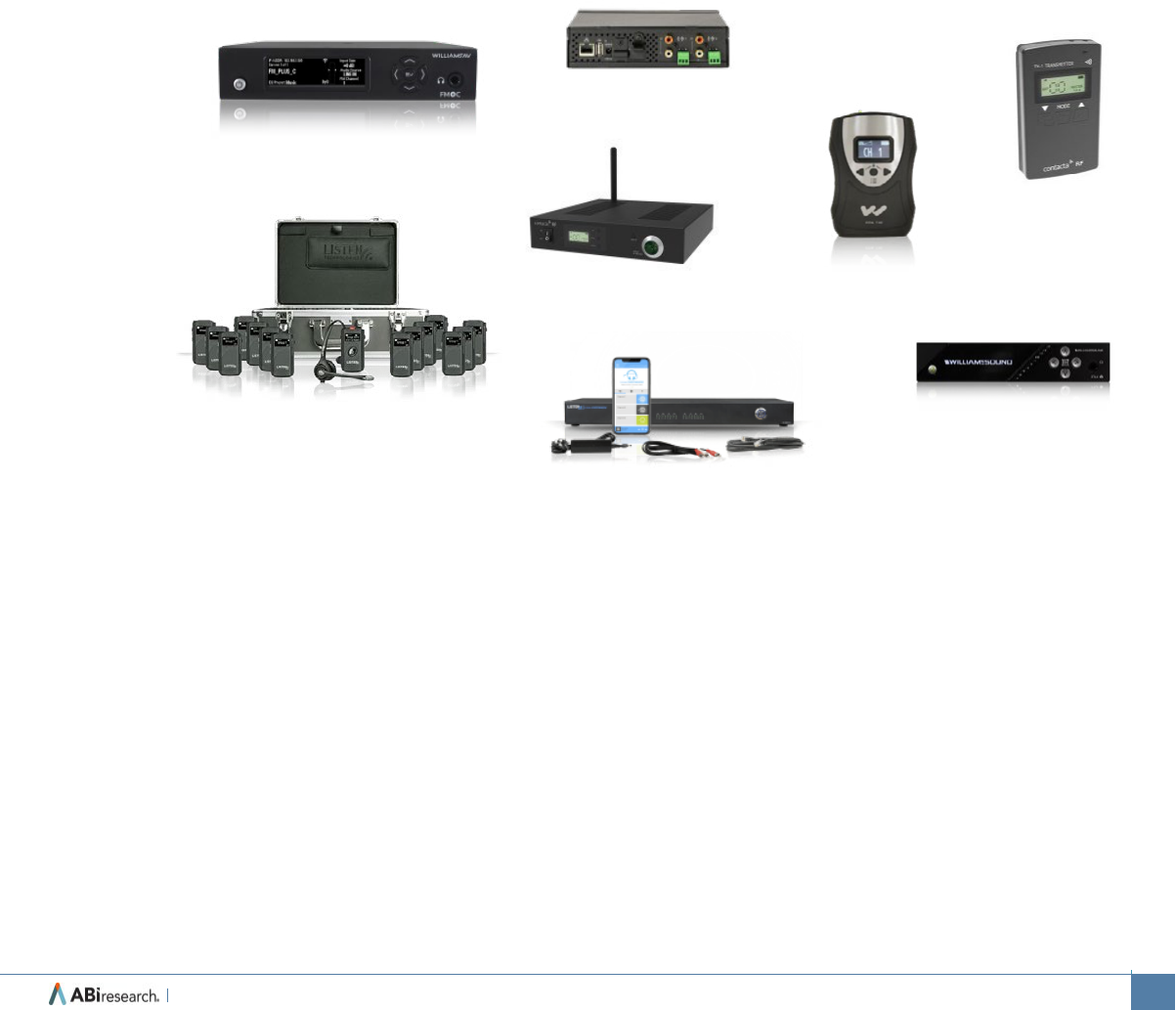
AURACAST™ BROADCAST AUDIO RETROFIT SOLUTIONS AND OPPORTUNITIES
12
www.abiresearch.com
AURACAST™ BROADCAST AUDIO TRANSMITTER
RETROFIT DEVICE CONFIGURATIONS
Retrot assistive and augmented listening transmitters are not a new invention. A core
element of many existing listening technologies such as Radio Frequency (RF), IR, FM,
and Wi-Fi-based solutions, is retrotting transmitters to various venue audio sources
that can broadcast the audio signal to receiver devices. These receiver devices can be a
dedicated headset or an assistive hearing device, a neckloop receiver, or a smartphone.
Figure 4 provides some examples of existing transmitters based on alternative
technologies.
Figure 4: Examples of Existing FM, RF, and Wi-Fi Assistive Listening
Transmitter Solutions
(Source: ABI Research)
There are many RF assistive listening deployments in public venues today. These can
provide many of the same benets to public spaces as an Auracast™ broadcast audio
system, including multi-channel, ease of setup, and low costs. However, these require
the venue to provide visitors with a dedicated RF-capable headset or receiver device
that can be connected to their hearing aid via a neckloop, or placing headphones over
the microphone of the user’s hearing device. In contrast, Auracast™ broadcast audio
users can bring their own devices, removing the need for locations having to manage
equipment and users being required to check out special equipment.
Wi-Fi assistive listening solutions can also provide a high-quality, simplied experience;
key benets include coverage, easy deployment, and minimal infrastructure. However,
this usually requires a smartphone with a dedicated app to connect to the stream
and typically has higher latency, providing an inferior user experience compared to
what Auracast™ broadcast audio will be able to oer. Auracast™ broadcast audio can
With nearly 740,000 public order and safety establishments globally, this
could represent a smaller, but still significant opportunity for retrofit
Auracast™ broadcast audio solutions.
Auracast™ Broadcast Audio Transmitter Retrofit Device Configurations
Retrofit assistive and augmented listening transmitters are not a new invention.
A core element of many existing listening technologies such as Radio Frequency
(RF), IR, FM, and Wi-Fi-based solutions, is retrofitting transmitters to various
venue audio sources that can broadcast the audio signal to receiver devices.
These receiver devices can be a dedicated headset or an assistive hearing
device, a neckloop receiver, or a smartphone. Figure 4 provides some examples
of existing transmitters based on alternative technologies.
Figure 4: Examples of Existing FM, RF, and Wi-Fi Assistive
Listening Transmitter Solutions
(Source: ABI Research)
There are many RF assistive listening deployments in public venues today. These
can provide many of the same benefits to public spaces as an Auracast™
broadcast audio system, including multi-channel, ease of setup, and low costs.
However, these require the venue to provide visitors with a dedicated RF-
capable headset or receiver device that can be connected to their hearing aid via
a neckloop, or placing headphones over the microphone of the user’s hearing
device. In contrast, Auracast™ broadcast audio users can bring their own
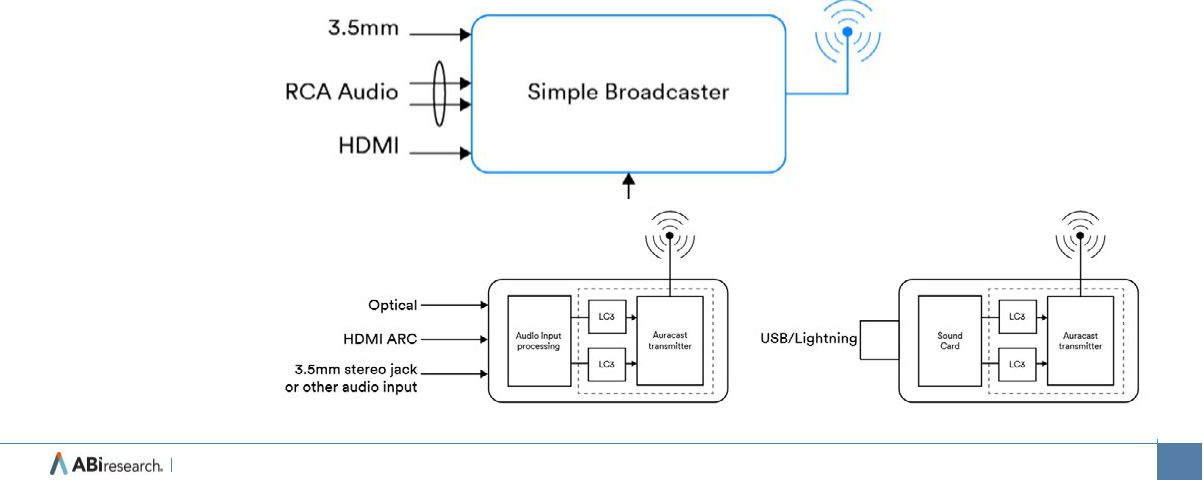
AURACAST™ BROADCAST AUDIO RETROFIT SOLUTIONS AND OPPORTUNITIES
13
www.abiresearch.com
go further by broadcasting directly to the receiver device and provides a lower latency
experience without the need for dedicated devices and neckloops. This can help reduce
the complexity and overall cost of the solution, alongside simplifying installation.
While hearing loops are also capable of working directly with hearing aids, Auracast™
broadcast audio can provide a higher quality experience, support for multiple sources
in a single location, and a much more streamlined, simplied, and cost-eective
deployment. In addition, Auracast™ broadcast audio can provide enhanced augmented
listening experiences such as unmuting silent TVs, multi-language support, audio
and tour guides, and potential new audio services within sports venues and other
entertainment environments.
Simple Auracast™ Broadcast Audio Retrofit Transmitters
As demonstrated, there is already a growing installed base of receiver devices that will
be capable of receiving Auracast™ broadcast audio broadcasts. This is expected to
rapidly accelerate over the next few years. Bluetooth
®
solution providers now have an
opportunity to develop retrot Auracast™ broadcast audio solutions that can provide
venues with assistive listening capabilities, alongside enhanced consumer experiences
across many dierent environments. The more venues that support Auracast™ broadcast
audio deployments, the greater the incentive for receivers to also support the technology,
which will, in turn, create a compelling consumer and public Auracast™ broadcast audio
ecosystem that enables users to take advantage of personal and public sharing use
cases. These solutions can be as simple as a USB, 3.5 Millimeter (mm), optical, or HDMI
dongle solution that can be plugged into any existing audio source. Figure 5 shows one
such example of a simple Auracast™ broadcast audio transmitter design. These designs
could apply to both consumer and public venue deployments, as well as multiple use
cases including silent TV, microphone, or wider audio equipment integration.
Figure 5: Example of Simple Auracast™ Broadcast Audio
Transmitter Designs
(Source: Bluetooth SIG)
(Source: Bluetooth SIG)
As ABI Research highlighted in its recent LE Audio: The Future of Bluetooth® Audio
report, more than 60 million venues globally could take advantage of Auracast™
broadcast audio technology. Considering that many of these venues could
deploy up to hundreds of Auracast™ broadcast audio transmitters depending on
the use case, it is clear that there is an enormous number of existing audio
sources that could be retrofitted to enable Auracast™ broadcast audio
technology. This represents the Total Addressable Market (TAM) for Auracast™
broadcast audio technology within public venues.
These simple Auracast™ broadcast audio transmitters can also capture
significant opportunities in the consumer market. There is already a wide range
and well-established market of retrofit Bluetooth® Classic transmitter and
receiver devices on the market that target automotive, gaming, and TV
applications. As LE Audio headsets become more widely available, there will be a
greater desire to retrofit existing owned devices such as smartphones, PCs, TVs,
games consoles, and AV systems for high-quality, low-latency connectivity,
enabling Auracast™ broadcast audio personal sharing use cases until embedded
(Source: Bluetooth SIG)
As ABI Research highlighted in its recent LE Audio: The Future of Bluetooth® Audio
report, more than 60 million venues globally could take advantage of Auracast™
broadcast audio technology. Considering that many of these venues could
deploy up to hundreds of Auracast™ broadcast audio transmitters depending on
the use case, it is clear that there is an enormous number of existing audio
sources that could be retrofitted to enable Auracast™ broadcast audio
technology. This represents the Total Addressable Market (TAM) for Auracast™
broadcast audio technology within public venues.
These simple Auracast™ broadcast audio transmitters can also capture
significant opportunities in the consumer market. There is already a wide range
and well-established market of retrofit Bluetooth® Classic transmitter and
receiver devices on the market that target automotive, gaming, and TV
applications. As LE Audio headsets become more widely available, there will be a
greater desire to retrofit existing owned devices such as smartphones, PCs, TVs,
games consoles, and AV systems for high-quality, low-latency connectivity,
enabling Auracast™ broadcast audio personal sharing use cases until embedded

AURACAST™ BROADCAST AUDIO RETROFIT SOLUTIONS AND OPPORTUNITIES
14
www.abiresearch.com
As ABI Research highlighted in its recent LE Audio: The Future of Bluetooth
®
Audio
report, more than 60 million venues globally could take advantage of Auracast™ broadcast
audio technology. Considering that many of these venues could deploy up to hundreds of
Auracast™ broadcast audio transmitters depending on the use case, it is clear that there
is an enormous number of existing audio sources that could be retrotted to enable
Auracast™ broadcast audio technology. This represents the Total Addressable Market
(TAM) for Auracast™ broadcast audio technology within public venues.
These simple Auracast™ broadcast audio transmitters can also capture signicant
opportunities in the consumer market. There is already a wide range and well-
established market of retrot Bluetooth
®
Classic transmitter and receiver devices on
the market that target automotive, gaming, and TV applications. As LE Audio headsets
become more widely available, there will be a greater desire to retrot existing
owned devices such as smartphones, PCs, TVs, games consoles, and AV systems for
high-quality, low-latency connectivity, enabling Auracast™ broadcast audio personal
sharing use cases until embedded LE Audio penetration increases. Dedicated USB-C,
HDMI, auxiliary dongles, transmitter, and receiver devices can help enable Auracast™
broadcast audio and LE Audio connectivity within existing devices such as smartphones,
PCs, games consoles, TVs, and other sources.
The TAM for the consumer retrot opportunity is the installed base of devices that can
benet from being equipped with an Auracast™ broadcast audio transmitter device,
including smartphones, TVs, PCs, tablets, personal audio systems, and game consoles.
While LE Audio source penetration will increase over time, given that there are still
many audio sources that do not support Bluetooth
®
or LE Audio (e.g., TVs, in-ight
entertainment units, tness equipment, and home and handheld gaming consoles),
having an in-box or aftermarket dongle or charging case that can support LE Audio
could be extremely desirable going forward in enabling low-latency connectivity in all
potential environments.
Only a small portion of this TAM will realistically be serviced before the transition to LE
Audio occurs. However, given the large active installed base of billions of source devices,
this means that even a small percentage penetration of retrotted solutions will equate
to a large potential market opportunity over the next 5 years. This could be serviced
by a combination of dedicated aftermarket LE Audio and Auracast™ broadcast audio
transmitters, in-box bundled dongles, or charging cases that can enable transmitter
functionality to a source via a USB or 3.5 mm cable. These charging cases could also
incorporate display functionality to enable them to be used as assistant devices for
stream selection in public venues. Gaming headsets may also come equipped with LE
Audio dongles to enable low-latency connectivity and to better compete with proprietary
wireless solutions. Consumer transmitter use cases may also help incentivize and speed
up development of Auracast™ broadcast audio transmitter reference designs and
products for use within public venues. Due to lengthy hearing aid replacement cycles,
retrot Auracast™ broadcast audio neckloop receiver solutions could enable Auracast™
broadcast audio support for existing users of assistive listening devices.

AURACAST™ BROADCAST AUDIO RETROFIT SOLUTIONS AND OPPORTUNITIES
15
www.abiresearch.com
CONCLUSION AND STRATEGIC
RECOMMENDATIONS
According to ABI Research, there more than 60 million venues globally that could
potentially benet from assistive listening or augmented audio experiences. Some of
these venues may support multiple use cases, ranging from assistive listening solutions
to silent TV use cases, or the emergence of new audio experiences. With the potential
for multiple audio transmitters per venue, this equates a very large potential TAM for
retrot Auracast™ broadcast audio solutions.
Long replacement cycles mean that it will be several years before these audio systems,
silent TVs, and other public audio sources are embedded with Auracast™ broadcast
audio capabilities as standard. Retrotted solutions oer the promise to enable both
new consumer-facing and assistive listening experiences without the need to wait to
replace existing audio systems with ones embedded with Auracast™ broadcast audio
technology. When compared to alternative assistive listening technologies, Auracast™
broadcast audio solutions can be deployed simply, at a comparatively low cost, and
provide unique audio experiences to users of both assistive listening devices and
mainstream consumer headsets. To recap, some of the major benets of creating
retrotted transmitter solutions include:
• The ability for venues to enable hearing accessibility and enhanced visitor
experiences relatively simply without the need to replace or upgrade all devices.
• Multi-functional transmitters/dongles can be used for both public and personal
use cases within the home. This can help reduce design complexity, enable shared
development cycles, and bring greater Return on Investment (ROI). Retrotting
solutions across both environments will be key in raising awareness of LE Audio and
Auracast™ broadcast audio technology.
• Personal and public venue Auracast™ broadcast audio deployments have the
potential to benet each other, while using similar solutions that can enable sources
and receivers to transmit and hear Auracast™ broadcast audio streams.
• Depending on the rollout approach and availability of solutions, tens of millions
of Auracast™ broadcast audio-capable solutions could ship over the next 5 years,
driving signicant additional Bluetooth
®
chipset and device volumes in both
consumer and public use cases.
LE Audio retrotted products and chipsets are already starting to emerge, and some
vendors are already noticing and targeting opportunities in this space. Retrot solutions
will be critical in forging the initial LE Audio and Auracast™ broadcast audio ecosystem

AURACAST™ BROADCAST AUDIO RETROFIT SOLUTIONS AND OPPORTUNITIES
16
www.abiresearch.com
system before mainstream adoption occurs toward the second half of the decade. To
help accelerate this, there is a need to further develop retrot Auracast™ broadcast
transmitter devices that can be readily integrated into various audio systems, TVs, PA
systems, speakers, microphones, and other audio source devices already deployed in
public venues. While the rst of these have come to market, ABI Research expects that
many more solutions will emerge over the next 12 months. These devices will be critical
in raising awareness of Auracast™ broadcast audio technology and helping accelerate
wider adoption of the technology and ecosystem within both consumer and public
venue applications.
Venues and solution providers currently looking to deploy alternative RF, Wi-Fi, and
other audio systems for both consumer and assistive listening use cases should
consider the numerous potential benets of deploying Auracast™ broadcast audio
technology as a future-proof alternative.
In addition to increasing the availability of retrotted solutions and accelerating wider LE
Audio and Auracast™ broadcast audio adoption in receiver devices, ABI Research oers
the following recommendations to help further develop the Auracast™ broadcast audio
ecosystem:
• Continue the proliferation of LE Audio and Auracast™ broadcast audio hardware and
software support.
• Emphasize both consumer and assistive listening use cases.
• Incentivize Auracast™ broadcast audio adoption in new buildings and within assistive
listening regulatory frameworks across dierent regions.
• Partner with system integrators to help roll out Auracast™ broadcast audio solutions
across larger venues and entire market segments.
• Develop intuitive user interfaces for Auracast™ broadcast audio.
• Raise greater awareness of what Auracast™ broadcast audio can do, where and how
easily it can be deployed, and how it can be used most eectively.
• Oer diverse transmitter and integrated solutions spanning both larger-scale public
assembly systems and portable transmitters, countertop solutions, and solutions that
can be easily connected to the widest variety of sources.
• Ensure that all Auracast™ broadcast audio experiences are high-quality, intuitive, and
standardized, regardless of where they are implemented.
• Ensure a standardized approach to security for Auracast™ broadcast audio solutions
deployed in one-to-one and private settings.
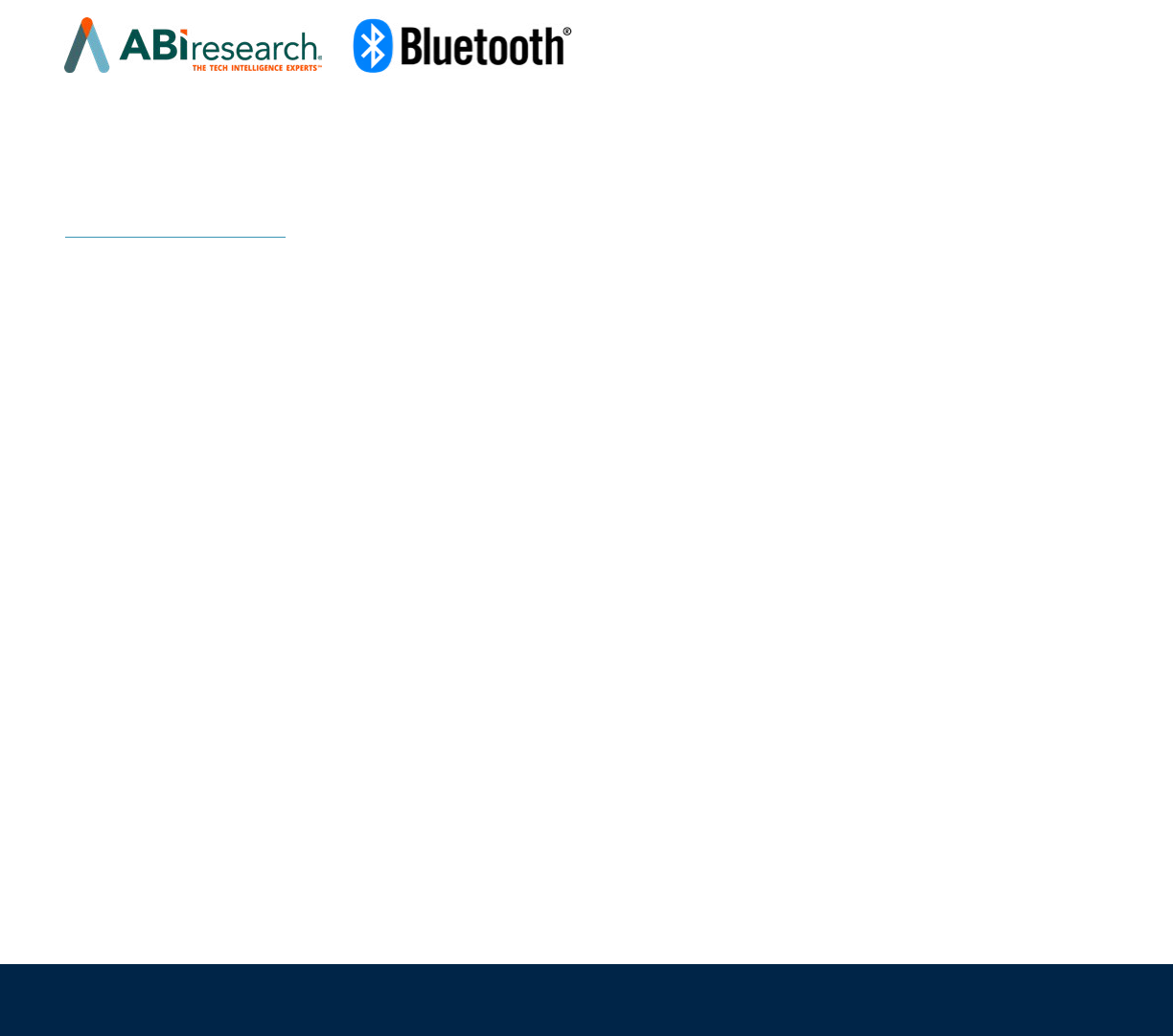
We Empower Technology Innovation and Strategic Implementation.
ABI Research is uniquely positioned at the intersection of end-market companies and technology solution providers, serving as the
bridge that seamlessly connects these two segments by driving successful technology implementations and delivering strategies that
are proven to attract and retain customers.
©2024 ABI Research. Used by permission. ABI Research is an independent producer of market analysis and insight and this ABI
Research product is the result of objective research by ABI Research sta at the time of data collection. The opinions of ABI Research
or its analysts on any subject are continually revised based on the most current data available. The information contained herein
has been obtained from sources believed to be reliable. ABI Research disclaims all warranties, express or implied, with respect to
this research, including any warranties of merchantability or tness for a particular purpose.
Published March 2024
157 Columbus Avenue
New York, NY 10023
Tel: +1 516-624-2500
www.abiresearch.com
